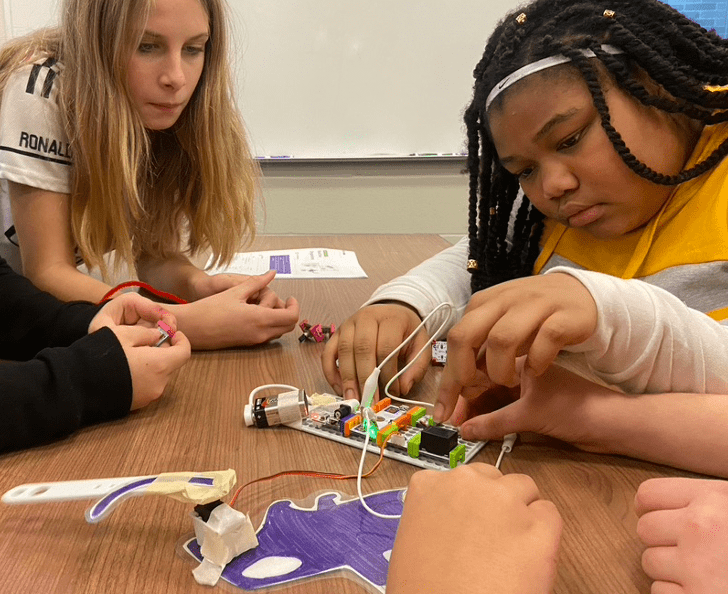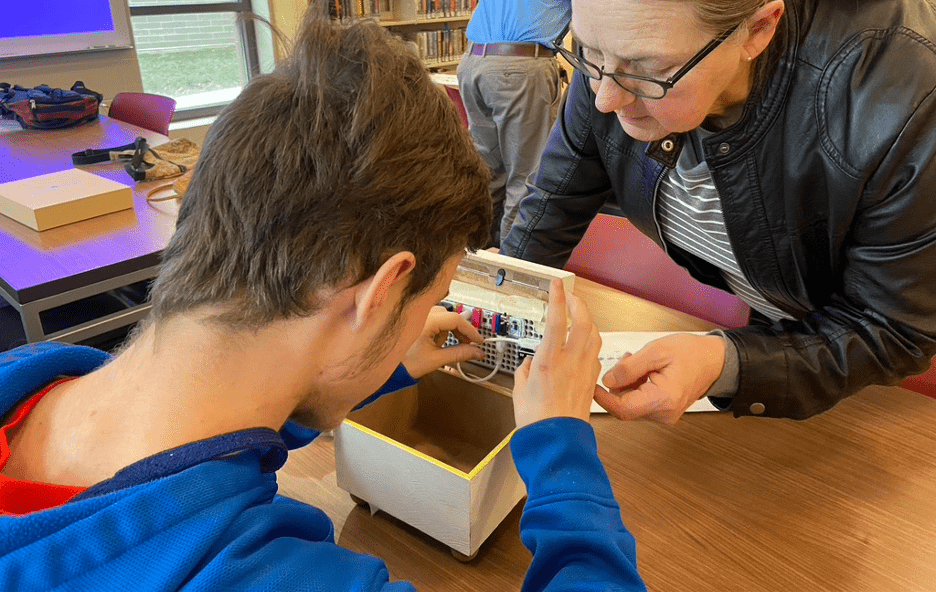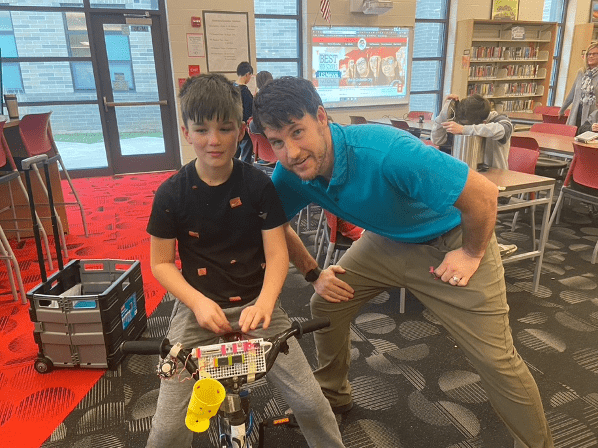littleBits: Hands-on Prototyping and Learning with Modular Electronics
By: Meghan Thoreau, OSU Extension Educator in Community Development programmatic focus on STEM Education and Career Exploration.

Program photos showing youth grouped into workstations listening to Educator’s lesson overview. Photographed by Trent Roberts.
Teaming up with K-12 educators is essential to keeping Extension programs dynamic and relevant to what students are currently learning and accessing in their school districts. Partnering with local schools also gives my programs the advantage of utilizing new school-owned technologies.
For example, this past year I partnered with Trent Roberts, Media Specialist in the Circleville City Schools District. I utilized the district’s Little Bits classroom kit to teach in their Extra Mile program to a group of 6th graders and a group of 7th-8th graders. The four-day electronics series spanned over a month and engaged the students in the engineering design process and prototyping.
Program Video Highlight
Circleville Middle School’s Extra Mile Program: littleBits series program highlight video, produced by Meghan Thoreau in iMovies.
Four Day Lesson Plan
LittleBits has easily accessible lesson plans, educator guides, activities, troubleshooting tips, and customizable handouts for different grades, subjects, and learning pathways. I developed my program by researching and filtering their online resources and videos, then customizing the materials to fit my programming needs. Three of the four days included custom presentations that walked students through the basics of electronics, differentiating modular Bits, connecting the challenges to real-world applications, building terminology, and highlighting each day’s challenges.
Day 1: Little Bits overview (60+ minutes)
Focused on the following topics: What are Little Bits? How do they work? How Little Bits connect to real-world applications? What is the design thinking/engineering design process? Students into small groups offering them two-challenge options: 1) Invent an Art Machine and 2) Invent Electric Car. Allowed students time to remix their prototypes.
Teaching Presentation of littleBits Day 1, created by Meghan Thoreau in Prezi.
STEM education is supposed to mirror the problem-solving mindset required in the real world. Real problems are solved with a multidisciplinary approach, rather than applying one subject at a time. LittleBit electronics provide the perfect overlay tools to teach simultaneous subjects such as biology, math, physics, electronics, music, art, and more through prototyping solutions. For example, day-two lessons used electronics to prototype and simulate biology and environmental concepts. (Several add-on components were customized ahead of time for the students due to time constraints, such as already cut and laminated animals’ parts for easy assembly, dismantle, and reuse for back-to-back programming.)
Day 2: Little Bits Reactive Organisms Challenge (60+ minutes)
Focused on the following topics: creature connections, animal senses, and animal food web. All of the design challenges incorporate the design thinking process. Students again divided into small groups, offering three-challenge options: reactive organisms’ challenges. Students had time to remixing prototype designs.

Middle school students work through a reactive organism design challenge. Photographed by Meghan Thoreau.
Teaching Presentation of littleBits Day 2, created by Meghan Thoreau in Prezi.
Day 3: Security Device Challenge (60+ minutes)
Focused on alarm system designs using the design thinking process. Students divided into small groups, offering three-challenge options: invent a security device with time allowed for students to remix their prototypes.

The student is working through an alarm system design challenge using littleBits electronics. Photographed by Meghan Thoreau.
Teaching Presentation of littleBits Day 3, created by Meghan Thoreau in Prezi.
Day 4: Final Challenge (60+ minutes)
Focused on the following topics: break into small groups, three-challenge option: 1) Create something useful for your classroom, 2) Invent something for good, or 3) Create a moving piece of art. Students had to try to remix their prototype designs.

The student shows off his bike design solution with turn signal and horn solutions, joined by Trent Roberts, Media Specialist of Circleville City Schools. Photographed by Meghan Thoreau.
The Benefits
The benefits of incorporating littleBits technology into your programs and classrooms are substantial and multiskilled, honing and strengthening collaboration, creativity, and the application of higher-order thinking skills. Students become problem-solvers, designers, engineers, editors, and team players in working on a design project. The adaptability and instruction of this technology can be modified to accommodate a variety of age groups and skill levels. LittleBits can easily challenge older students as well. Students gain self-management skills as they break down tasks to accomplish a larger task, solving a larger problem. LittleBits allows students to cultivate skills that will serve them well in today’s workforce. Merging the learning with littleBits with the core curriculum is another value-added benefit.
“I Broke Science, Foil on Foil!”
Please enjoy the short snippet of a young STEMist that just broke science! For more information contact Meghan Thoreau, thoreau.1@osu.edu.
A student explains how he broke science in a short clip from littleBit program. Recorded by Trent Roberts.
References:
Brown, Stacy. (2018). Chapter 6. Big Impact with littleBits, Vol. 54, No. 4. Retrieved from https://journals.ala.org/index.php/ltr/article/view/6673/8953.
Dochshanov, Alden and Tramonti, M. (Janurary 2017). A Multidisciplinary Approach in STEM Education. Retrieved from https://www.researchgate.net/publication/317491980_A_Multidisciplinary_Approach_in_STEM_Education.
LittleBits. (n.d.). littleBits Classroom. LittleBits Classroom. Retrieved July 10, 2020, from https://www.littlebits.cc/welcome.
LittleBits. (n.d.). LittleBits: Select Your Kit. Https://Www.Littlebits.Cc/Getting-Started. Retrieved July 10, 2020, from https://www.littlebits.cc/getting-started.
Spencer, John and Juliani, A. J. (2017)Empower: What Happens When Students Own Their Learning, IMPress, 84.
Peer-Reviewed: Sally McClaskey, OSU Extension Program Manager, Education & Marketing. She develops and directs educational programs at the Nationwide & Ohio Farm Bureau 4-H Center.

Useful Information. Thank you for sharing this post.Visit my website – https://versadri.com/